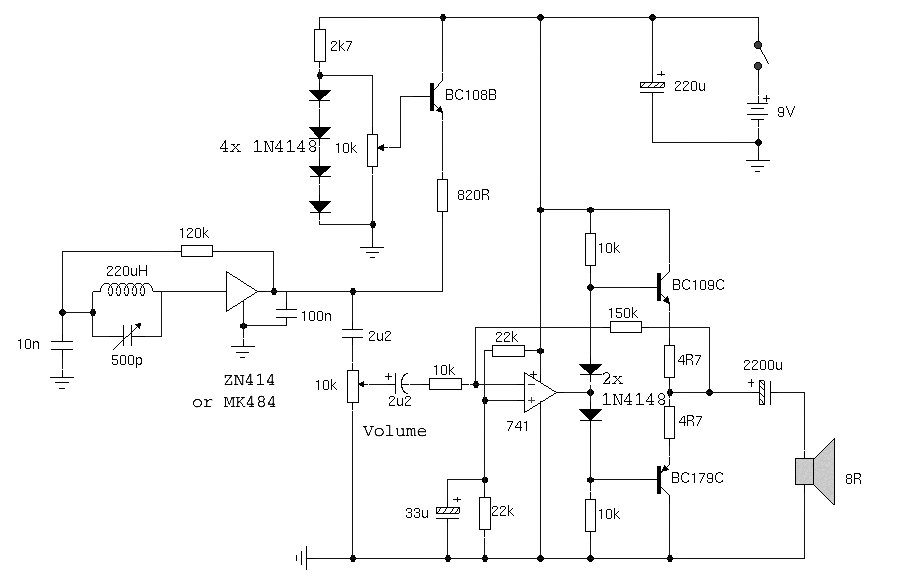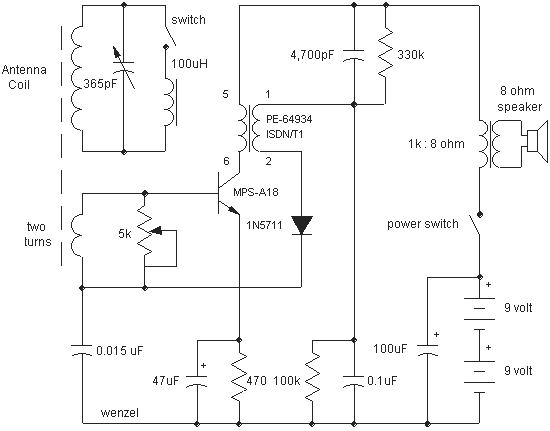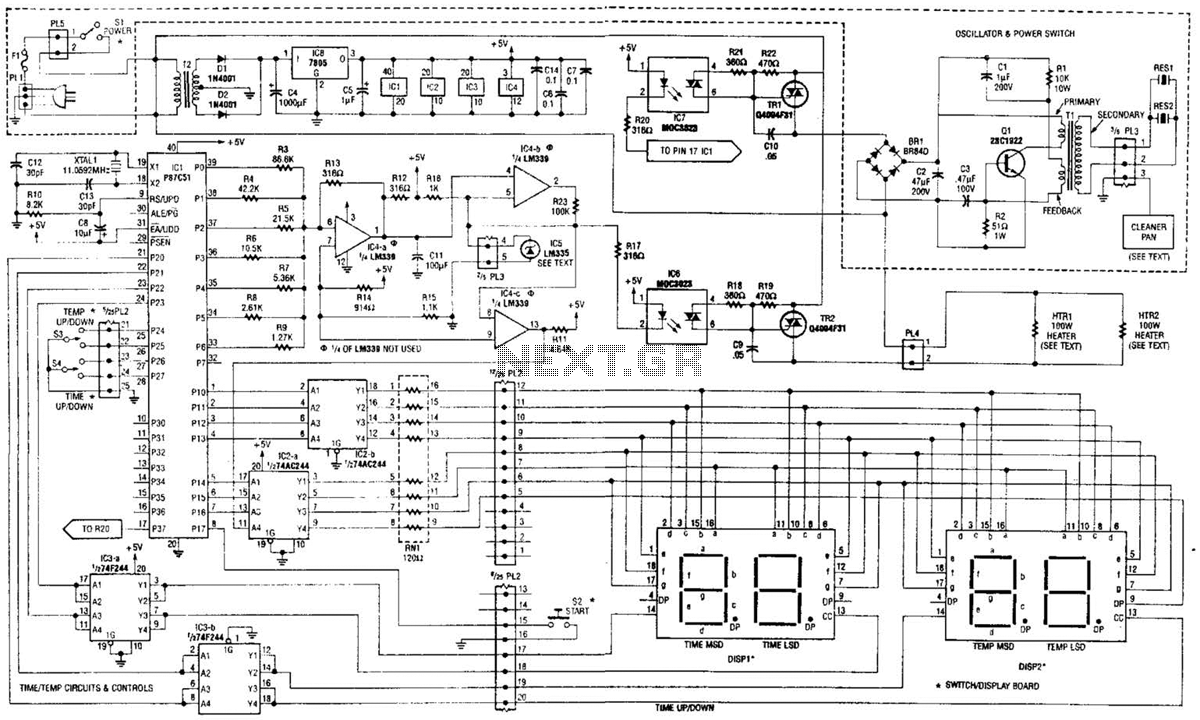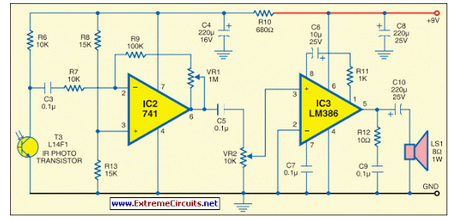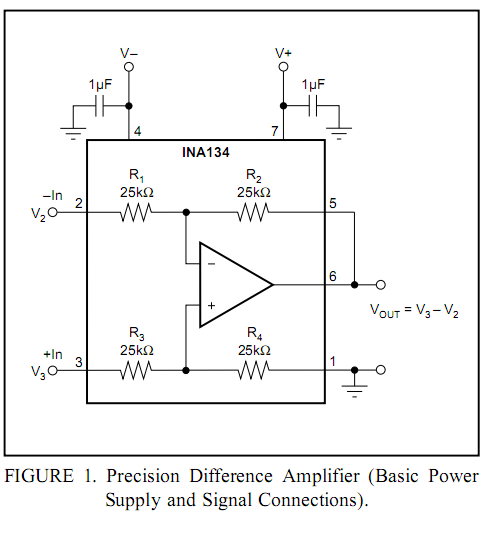
10 Mhz fiberoptic receiver
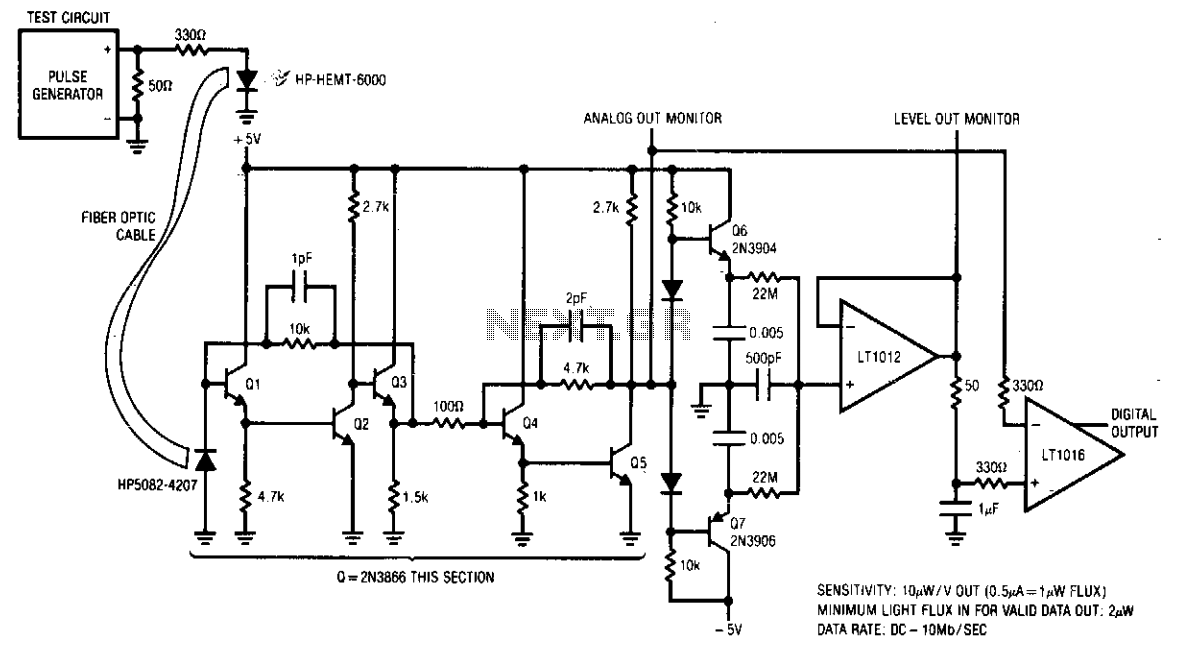
The receiver is designed to accurately condition a wide range of light inputs at data rates of up to 10 MHz. The optical signal is detected by a PIN photodiode and amplified by a broadband feedback stage comprising transistors Q1 to Q3. A second, similar amplification stage provides additional gain. The output from this stage, specifically the collector of Q5, is used to bias a two-way peak detector composed of transistors Q6 and Q7. The maximum peak is stored in the emitter capacitor of Q6, while the minimum excursion is retained in the emitter capacitor of Q7. The DC value of the output signal from Q5's midpoint appears at the junction of a 0.005 µF capacitor and a 22-ohm resistor. This point consistently remains at the midpoint between the signal's excursions, independent of the absolute amplitude. This signal-adaptive voltage is buffered by a low-bias LT1012, which sets the trigger voltage at the positive input of the LT1016. The negative input of the LT1016 is directly biased from the collector of Q5.
The described circuit functions as a high-speed optical signal receiver, suitable for applications requiring precise light input conditioning. The use of a PIN photodiode as the initial light detection component allows for efficient conversion of optical signals into electrical signals. The broadband feedback amplification stage (Q1-Q3) ensures that the signal is amplified effectively across a wide frequency range, maintaining fidelity and minimizing distortion.
Following the initial amplification, the design incorporates a second amplification stage that further increases the signal strength, allowing for robust processing of the optical input. The two-way peak detector (Q6-Q7) is essential for tracking the maximum and minimum levels of the input signal, enabling dynamic range compression and ensuring that the system can adapt to varying signal amplitudes without loss of information.
The junction of the 0.005 µF capacitor and the 22-ohm resistor serves a critical role in stabilizing the DC output signal from Q5. This midpoint voltage is crucial for setting a reference level that is independent of the signal's amplitude, allowing for consistent triggering of subsequent stages in the circuit. The buffering provided by the LT1012 ensures that this reference voltage is stable and low bias, minimizing any potential loading effects on the circuit.
The LT1016 comparator is utilized to process the buffered signal, with its positive input receiving the adaptive voltage and its negative input connected directly to Q5's collector. This configuration allows for accurate comparison and triggering based on the conditioned optical signal, facilitating rapid response times necessary for high-frequency applications. Overall, this circuit design exemplifies effective signal conditioning for high-speed optical communications, ensuring that input signals are accurately processed for further electronic analysis or transmission.The receiver will accurately condition a wide range of light inputs at up to 10 MHz data rates. The optical signal is detected by the PIN photodiode and amplified by a broadband fed-back stage, Q1-Q3. A second, similar, stage gives further amplification. The output of this stage (Q5's collector) biases a 2-way peak detector (Q6-Q7). The maximum peak is stored in Q6's emitter capacitor while the minimum excursion is retained in Q7's emitter capacitor.
The dc value of Q5's output signal's mid-point appears at the junction of the 0.005 µ capacitor and the 22 ohm unit. This point will always sit midway between the signal's excursions, regardless of absolute amplitude. This signal-adaptive voltage is buffered by the low bias LT1012 to set the trigger voltage at the LT1016's positive input.
The LT1016's negative input is biased directiy from Q5's collector.
The described circuit functions as a high-speed optical signal receiver, suitable for applications requiring precise light input conditioning. The use of a PIN photodiode as the initial light detection component allows for efficient conversion of optical signals into electrical signals. The broadband feedback amplification stage (Q1-Q3) ensures that the signal is amplified effectively across a wide frequency range, maintaining fidelity and minimizing distortion.
Following the initial amplification, the design incorporates a second amplification stage that further increases the signal strength, allowing for robust processing of the optical input. The two-way peak detector (Q6-Q7) is essential for tracking the maximum and minimum levels of the input signal, enabling dynamic range compression and ensuring that the system can adapt to varying signal amplitudes without loss of information.
The junction of the 0.005 µF capacitor and the 22-ohm resistor serves a critical role in stabilizing the DC output signal from Q5. This midpoint voltage is crucial for setting a reference level that is independent of the signal's amplitude, allowing for consistent triggering of subsequent stages in the circuit. The buffering provided by the LT1012 ensures that this reference voltage is stable and low bias, minimizing any potential loading effects on the circuit.
The LT1016 comparator is utilized to process the buffered signal, with its positive input receiving the adaptive voltage and its negative input connected directly to Q5's collector. This configuration allows for accurate comparison and triggering based on the conditioned optical signal, facilitating rapid response times necessary for high-frequency applications. Overall, this circuit design exemplifies effective signal conditioning for high-speed optical communications, ensuring that input signals are accurately processed for further electronic analysis or transmission.The receiver will accurately condition a wide range of light inputs at up to 10 MHz data rates. The optical signal is detected by the PIN photodiode and amplified by a broadband fed-back stage, Q1-Q3. A second, similar, stage gives further amplification. The output of this stage (Q5's collector) biases a 2-way peak detector (Q6-Q7). The maximum peak is stored in Q6's emitter capacitor while the minimum excursion is retained in Q7's emitter capacitor.
The dc value of Q5's output signal's mid-point appears at the junction of the 0.005 µ capacitor and the 22 ohm unit. This point will always sit midway between the signal's excursions, regardless of absolute amplitude. This signal-adaptive voltage is buffered by the low bias LT1012 to set the trigger voltage at the LT1016's positive input.
The LT1016's negative input is biased directiy from Q5's collector.

